The 2012 Hong Kong-Athens Cruise, part 2 of 6
- Wednesday, January 23 2013 @ 08:08 AM CST
- Contributed by: filbert
- Views: 10,177
The 2012 35-Day Hong Kong-Athens Cruise, Oceania ms Nautica, 2 of 6
Snookums woke up, showered and almost fainted. She had to sit on the toilet until the bright white lights dimmed. Snookums returned to the doctor at 8 AM for another temperature check and her temperature was normal but her blood pressure was 85/62 which is very low for her. She still didn’t feel well, either, and decided not to go on the Phuket tour. Filbert and Snookums had booked a Phuket tour with six other people and Filbert went since it needed to be paid for and there was nothing he could do for Snookums. Snookums stayed behind and watched movies. (This was the one tour that Snookums really wanted to do on the cruise since it involved riding an elephant.) Wat Chalong:
Filbert talked to the Premier Phuket tour leader right away and was not charged for Snookums’s no-show which was really nice. For $90, Filbert enjoyed the following places: Wat Chalong Temple, the Big Buddha, Prom Thep Cape which is the rocky headland that juts out into the sea at the far southwest of Phuket and has a nice view, an elephant ride and snake show, lunch at Baan Chom View Restaurant, and shopping at OTOP market in Patong (he didn’t really enjoy the shopping stop and said it was the normal tourist junk).
Filbert learned that Phuket has a registered population of 30,000 and if seasonal workers are included, the population is around two million. 70% are Buddhist and 30% are Muslim. Tourism is Phuket’s main industry.
Filbert returned to the ship around 4 PM and found Snookums in bed with her headache. On his elephant ride Filbert bought Snookums a $10 elephant necklace from the mahout. (He figured it was the mahout’s tip.) Snookums thought it was nice, although neither Filbert nor Snookums are sure how to get it on since it is very tiny, but too big for a bracelet. Maybe it’s a child’s necklace?
Filbert went to the ship’s store and bought Tylenol ($8.99) for Snookums since she was still unable to convince the doctor to give her any. The doctor insisted that the other two ingredients in Comtrex (the decongestant and the antihistamine) were needed to fight her virus! Snookums threw away the Vitamin C tablets. What a quack….. And, to add insult to injury, the bill for Snookums’s doctor visit was delivered to the cabin today -- $641! It’s a good thing we have trip insurance!!
April 22 (Sunday, Day 17, Cruising the Andaman Sea) -
April 23 (Monday, Day 18, Cruising the Bay of Bengal) -
We attended the lecture given by Captain Leo Strazicic about modern day pirates. We learned that from the time we leave Mumbai, India until we dock at Aqaba, Jordan, we will be in a High Risk Area. While sailing through the High Risk Area, our ship will be in permanent contact with the International Task Force, including U.S. and U.K. naval forces that are assigned to protect merchant vessels from pirate attack by a United Nations mandate. While in the Gulf of Aden (the most dangerous part), our ship will be passing through the area using an internationally approved transit corridor. Additional security personnel will join the ship in Mumbai, fire hoses will be rolled out on Deck 5 and outside lights will be turned off at night in order to reduce the ship’s external lighting. It was very interesting and no one is worried.
April 24 (Tuesday, Day 19, Cruising the Bay of Bengal) –
April 25 (Wednesday, Day 20, Cochin, India; 1 INR = $0.02; $1 = 51.66 INR) -
We had been to Cochin before and had pretty much decided to not get off the ship. However, as we started docking, Snookums decided that maybe seeing a doctor would be a good idea. (Filbert had mentioned it the night before but Snookums said “no”.) Snookums was still dealing with a headache and mild nausea and just wasn’t having a very good time and finally decided to see what was going on. We went to the Executive Concierge to get the name of a doctor and he wanted us to talk to the ship’s doctor. We explained that the ship’s doctor was an idiot and we didn’t want to get any information from him. The Executive Concierge went to the port agent and came back with a doctor’s name and location (but not an address since Cochin must not have addresses) for us. We got off the ship and the cab drivers immediately descended upon us. We showed the paper to them and one guy said “$50”. We said “no” and kept walking. Then someone said “Not $50, $15.” Well, $15 sounded better so we said okay and got in a cab. The driver drove for at least 20 minutes and finally turned down this little alley and stopped the car. The cab driver didn’t speak much English but he got out with us and pointed to the “clinic”. We saw anchors on the door and a sign that had the doctor’s name on it. We waited outside under the carport for around 15 minutes and then were motioned inside. Snookums explained to the doctor, who was sitting at an office desk in the one room that we could see, that she had a bad fever and now still has a headache and mild nausea. The doctor said that Snookums needed to see an internist and that she needed to see a female doctor so that Snookums could tell the doctor her “other problems”! Well, Snookums didn’t have any other problems but she wasn’t surprised that she would be pawned off on a female doctor since this was India after all.
By the way, it appeared that this male doctor was a doctor that specialized in getting paperwork approved for Indians who wanted to work on ships. That’s why there were anchors on his door. We didn’t see any exam rooms but his outside waiting room was full of men that would meet with him and then leave holding a piece of paper. He probably was a real MD, but didn’t really practice like one.
He made a phone call and then told us that he made an appointment for us with a female doctor and that we needed to take his office boy with us and he would show the cab driver where to go. So, the cab driver drove the office boy and us to the Medical Trust Hospital in Cochin. (We learned later in Mumbai that a trust hospital is a public hospital and most Indians go to private hospitals.) The cab driver needed $1 for parking the car in the hospital’s dirt parking lot and then the office boy led us into the hospital and a small room that said “International Patients” and Snookums filled out some basic paperwork. Then the female office worker said “220” and we didn’t know if she meant dollars or rupees. She meant 220 rupees ($4.25) and this 220 rupee bill was split between 150 rupees ($2.90) for the doctor’s consultation and 70 rupees ($1.35) for the registration charge. We had no rupees so a “candy-striper” took us to the ATM on the second floor. While we were making the short hike, we passed tons of people as well as a large cart full of lunch trays. They were all hermetically sealed and looked like the type of hospital food that you would get in a US hospital. Snookums was impressed by what she saw.
After we got our rupees, we returned to the small office and paid our 220 rupee bill. Then we were taken to the doctor’s office. However, the doctor wasn’t ready to see Snookums yet so we waited in a large waiting room that was FULL of Indians. Filbert and Snookums stuck out like a sore thumb since all the other people were Indians. The waiting room was surrounded by the doctors’ exam rooms and every now and then some of the Indians would get up and go into one of the exam rooms. We never figured out how they knew when it was their turn, but they did. After 15 minutes or so, the candy-striper said it was Snookums’s turn and apologized profusely for the wait. We know that we were being put to the front of the line and didn’t mind the wait at all. Snookums and Filbert entered the exam room and found a female doctor behind a desk and two cheap plastic patio chairs on the other side. We sat down and the doctor said something and the office boy (from the first male doctor) and the candy-striper left. The nurse stayed in the room. Snookums explained her symptoms along with the two bug bites that she received in Bangkok. The doctor used an old-fashioned large metal flashlight (like Snookums used to take on her Girl Scout campouts before the era of plastic flashlights) to look in her eyes and her throat. Her blood pressure was taken, too, as was her temperature (via a thermometer placed in her armpit since that way it wouldn’t need to be sterilized!) while Snookums was sitting on the exam table with fabric sheets covering it (and not throwaway paper sheets). The doctor said that she wanted blood to be taken and would test for Dengue fever but she thought everything was fine and wasn’t going to prescribe anything. The doctor explained that it would take three days to get the lab results and when Snookums explained that the ship was leaving in a few hours and suggested that the results be emailed to her, the doctor agreed.
The candy-striper then took Snookums and Filbert to the blood work office and Snookums had to give a total of 659 more rupees ($12.76) for: Dengue fever antibody (600 rupees - $11.61), platelet count (50 rupees - $0.97) and single-use syringe (9 rupees - $0.18). After paying, Snookums went into the blood work room and a woman took her blood. The office worker at the desk hand labeled the two test tubes that would hold Snookums’s blood. After the worker took Snookums’s blood, she put the syringe with the blood in it in this rusty little box and then sparks came out. She removed the syringe from the box and Snookums saw that the single-use syringe was bent out of shape. Snookums thinks that the rusty little box was actually a grinder that ground off the syringe to prevent it from being used again. That’s what poverty is all about! The woman then poured the blood into the two hand labeled test tubes and put a Band-Aid on Snookums’s arm. Snookums, Filbert and the office boy returned to the international patients office and Snookums was given her official Medical Trust Hospital registration card (like a credit card) and was told that her lab results would be emailed to her. The office boy called the cab driver and we got in the cab to take the office boy back to the first doctor.
The office boy wanted Snookums to meet with the male doctor so she told him what happened and he wanted to make sure she understood that the lab results would be emailed to her. After five minutes or so of the male doctor talking about irrelevant things, Snookums said “thanks” and left. She expected to have to pay the male doctor something and figured that is why the office boy wanted her to see the male doctor again, but that was not the case. The office boy was with us for at least one hour plus Snookums “saw” the male doctor and there was no charge for any of this at all!
We got back in the cab and told the driver to take us back to the ship. The driver really wanted to take us on a tour but Snookums kept saying “No, I’m sick”. She wasn’t feeling bad, but she had no interest in seeing Cochin. We weren’t sure if our original $15 quote for the cab ride was one-way or round trip, but given that the driver was with us for around 3 hours, we decided to give him $30 when we got back to the ship just to be safe. What a day. We spent $30 for a cab and $18.01 for doctor visits and lab work. Only in India!
April 26 (Thursday, Day 21, Cruising the India Ocean) -
The pirate drill was today but we told our room stewardess we weren’t going to do it since Snookums still wasn’t feeling 100%. At 10:30 AM, the drill occurred and people had to go to corridors and stay low in order to not fall if the ship had to make sharp turns to get away from pirates.
April 27 (Friday, Day 22, Mumbai, India; 1 INR = $0.02; $1 = 51.66 INR) -
We met our guide, along with another couple from another ship, and immediately drove to the Taj Mahal Palace Hotel which is located across from the Gateway of India. We had seen this before and weren’t too interested. But our guide wanted us to see the memorial to the people that died during the November 26, 2008 terrorist attacks so we went in the hotel. Then we drove to the Dharavi slums, an area half the size of New York’s Central Park, occupied by around 1 million people. This area contributes anywhere from $500 million to $1 billion to Mumbai’s economy.
We started our walking tour by seeing several recycling programs. A dark, single car garage-like structure had six or seven workers squatting in a row while passing trash down the human/manual assembly line. These workers were dwarfed by a huge mound/wall of garbage that reached the tall ceiling. The first person would take out specific types of recyclables and then scoot the garbage to the next person who would do something similar. It was kind of amazing to see this. We went to another recycling place and this one was only for women to work in since some of them don’t feel comfortable working so close to men due to their religious beliefs. (30% of Dharavi residents are Hindus and the rest are Muslim.) Then we went to a bakery where the rolls were stacked out front in wooden crates with flies and things crawling on them.
Most of what is produced in the slums is sold throughout Mumbai (and the world) at leading establishments which is why photos aren’t always allowed. Indians don’t want people knowing where some of the Indian goods are coming from. After the bakery we saw a cardboard recycling shop that contained huge bundles of cardboard and some of it seemed to have been somehow made into “wood”. Most of these places didn’t have any machinery. The bakery had a wood-burning oven. We weren’t sure what happened to the sorted mounds of recyclables but six or seven workers were working in each small recycling shop. We also saw an oil can recycling shop and this had four girls squatting and using awful smelling chemicals to scrub the labels off the huge oil cans. The chemicals were definitely caustic and couldn’t be healthy and made our eyes run but the girls didn’t have any kind of protective gloves or masks. Our guide told us that after the oil cans were cleaned they would be refilled with cooking oil and sold. She said that the street vendors often use this kind of oil and that’s why people sometimes get sick from eating Indian street food. Reputable restaurants buy sealed news cans of cooking oil to use.
We kept walking through narrow alleys and some of the buildings (definitely slums – there was no rhyme or reason as to how they were built) appeared to have the industry on the ground floor with living space on the second floor. There were also some buildings that just housed families in what looked like single rooms and a kitchen. Kids seemed to be everywhere and no one minded them. Scooters would drive through the alleys where the kids were playing cricket and where women would walk with pottery on their head. You definitely had to be awake to make sure you weren’t in the way. And, it was sunny, humid and 97° and not comfortable at all.
We also saw several places that had ten people using sewing machines to make blue jeans and another place that had ten men making frilly dresses. We were taken into these one room places and had to step over fabric, food, and finished products. Stuff was just everywhere. Snookums saw a mouse running in one of the places and we all saw a slowly dying rat in an alley. Sanitation wasn’t a high priority and there didn’t appear to be any indoor plumbing since we saw one man brushing his teeth in the alley with a wash basin of water.
We then walked to the section of Dharavi that was the leather tannery section and saw a few men tanning leather. None of these operations were big. The frilly dress place had ten men working in it but it seemed like the other industries had less than five or so employees. We also saw the area where several pottery places were in business. It didn’t seem like any of these industries were selling any of the products to the locals. They appeared to be strictly wholesale. Even the bakery seemed to be making its rolls to sell to one buyer.
One of the last industries that we saw was the pappadam area. This was where women were given pappadam dough each morning and they would squat in front of their homes and roll it into flat, plate-sized shapes and then put them on drying racks and let them bake/dry in the sun. The women didn’t wear gloves and the drying racks weren’t protected. It should be noted that there were dogs running around, too. Our guide said that basically all of the pappadam bread that is eaten in Mumbai is made like this in the slums and this was one area where absolutely no photos were allowed. After seeing it, we weren’t going to eat any pappadam!
By now we were all very hot and sweaty and piled back in the air-conditioned car. The driver took us back to the port and the other couple left. Filbert and Snookums stayed in the car since Snookums really wanted to buy mojari shoes. She bought a pair in Hyderabad, India when they visited Snookums’s sister there several years ago and she wanted more. The guide took us to Colaba, which is the unofficial headquarters of Mumbai’s tourist scene with lots of touts, stores, stalls, hotels, a movie theatre and even a McDonald’s. We went into a couple of fancy shoe stores like you would find in the U.S. but the shoes didn’t feel right. As we walked down the street, the guide would stop at various shoe places and ask, in Hindi, about the shoes. She finally found a little stall that was literally built on either side of three exterior steps leading into a building. This is where Snookums found two pairs of mojaris for around $12 each. Even though we had the guide for another hour or two, we asked to return to the ship where we showered and put India behind us.
Snookums wanted to see dhobi ghat, the world’s largest outdoor laundry (all manual labor, of course), but she was tired and hot and called it a day. It had been a hot day and Filbert thought it was depressing. Snookums was amazed that people can live and work like that and have such a positive attitude. Our guide kept saying that they work hard in order to improve their lives and that is definitely what we saw. When we were in Rio de Janeiro, Brazil we visited its favelas (slums) but they were much nicer than Mumbai’s.
Text and pictures by Snookums, webification by Filbert
Part Two
(Remember to click "read more" if you're looking at this from the main medary.com page to get the whole article!)
April 21 (Saturday, Day 16, Phuket, Thailand; 1 THB = $0.03; $1 = 30.81 THB) -
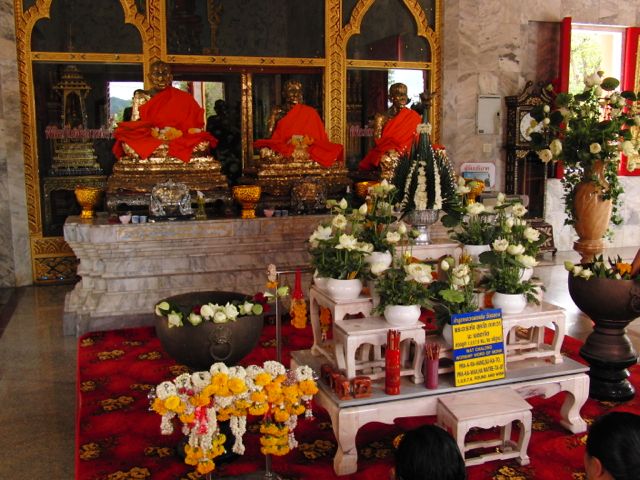 |
| Shrine |
Snookums woke up, showered and almost fainted. She had to sit on the toilet until the bright white lights dimmed. Snookums returned to the doctor at 8 AM for another temperature check and her temperature was normal but her blood pressure was 85/62 which is very low for her. She still didn’t feel well, either, and decided not to go on the Phuket tour. Filbert and Snookums had booked a Phuket tour with six other people and Filbert went since it needed to be paid for and there was nothing he could do for Snookums. Snookums stayed behind and watched movies. (This was the one tour that Snookums really wanted to do on the cruise since it involved riding an elephant.) Wat Chalong:
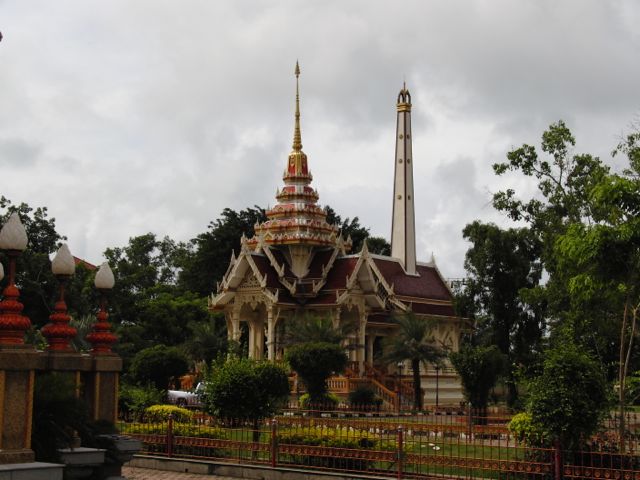 |
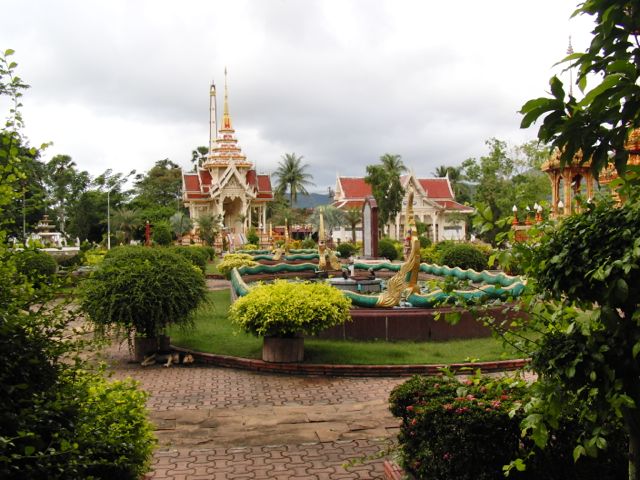 |
Filbert talked to the Premier Phuket tour leader right away and was not charged for Snookums’s no-show which was really nice. For $90, Filbert enjoyed the following places: Wat Chalong Temple, the Big Buddha, Prom Thep Cape which is the rocky headland that juts out into the sea at the far southwest of Phuket and has a nice view, an elephant ride and snake show, lunch at Baan Chom View Restaurant, and shopping at OTOP market in Patong (he didn’t really enjoy the shopping stop and said it was the normal tourist junk).
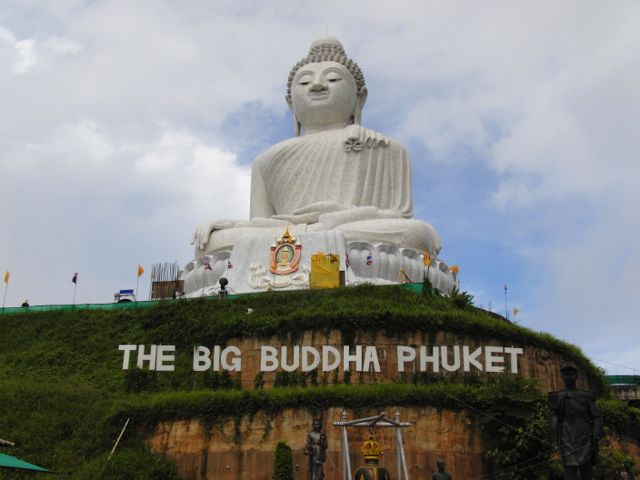 |
| The Big Buddha |
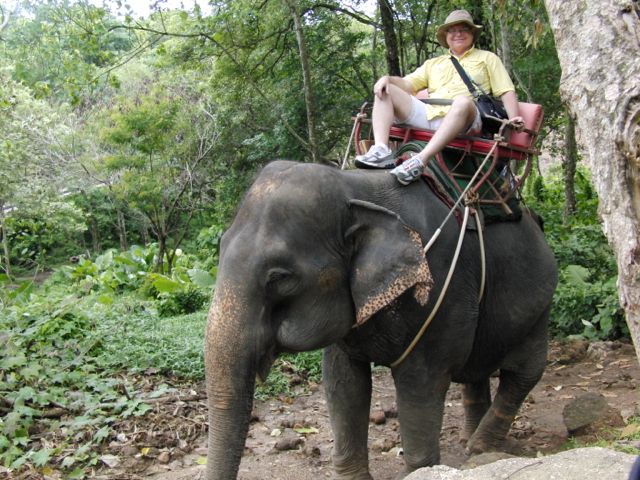 |
| The elephant's the one with the four legs |
Filbert learned that Phuket has a registered population of 30,000 and if seasonal workers are included, the population is around two million. 70% are Buddhist and 30% are Muslim. Tourism is Phuket’s main industry.
Filbert returned to the ship around 4 PM and found Snookums in bed with her headache. On his elephant ride Filbert bought Snookums a $10 elephant necklace from the mahout. (He figured it was the mahout’s tip.) Snookums thought it was nice, although neither Filbert nor Snookums are sure how to get it on since it is very tiny, but too big for a bracelet. Maybe it’s a child’s necklace?
Filbert went to the ship’s store and bought Tylenol ($8.99) for Snookums since she was still unable to convince the doctor to give her any. The doctor insisted that the other two ingredients in Comtrex (the decongestant and the antihistamine) were needed to fight her virus! Snookums threw away the Vitamin C tablets. What a quack….. And, to add insult to injury, the bill for Snookums’s doctor visit was delivered to the cabin today -- $641! It’s a good thing we have trip insurance!!
April 22 (Sunday, Day 17, Cruising the Andaman Sea) -
April 23 (Monday, Day 18, Cruising the Bay of Bengal) -
We attended the lecture given by Captain Leo Strazicic about modern day pirates. We learned that from the time we leave Mumbai, India until we dock at Aqaba, Jordan, we will be in a High Risk Area. While sailing through the High Risk Area, our ship will be in permanent contact with the International Task Force, including U.S. and U.K. naval forces that are assigned to protect merchant vessels from pirate attack by a United Nations mandate. While in the Gulf of Aden (the most dangerous part), our ship will be passing through the area using an internationally approved transit corridor. Additional security personnel will join the ship in Mumbai, fire hoses will be rolled out on Deck 5 and outside lights will be turned off at night in order to reduce the ship’s external lighting. It was very interesting and no one is worried.
April 24 (Tuesday, Day 19, Cruising the Bay of Bengal) –
April 25 (Wednesday, Day 20, Cochin, India; 1 INR = $0.02; $1 = 51.66 INR) -
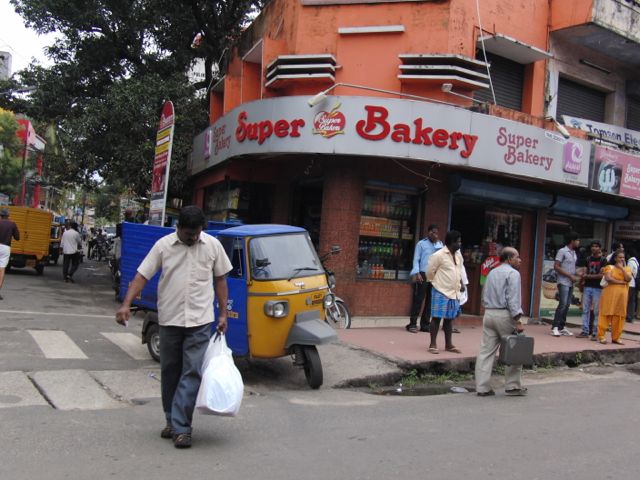 |
| This photo brought to you by the Medical Tourism Board of Cochin |
We had been to Cochin before and had pretty much decided to not get off the ship. However, as we started docking, Snookums decided that maybe seeing a doctor would be a good idea. (Filbert had mentioned it the night before but Snookums said “no”.) Snookums was still dealing with a headache and mild nausea and just wasn’t having a very good time and finally decided to see what was going on. We went to the Executive Concierge to get the name of a doctor and he wanted us to talk to the ship’s doctor. We explained that the ship’s doctor was an idiot and we didn’t want to get any information from him. The Executive Concierge went to the port agent and came back with a doctor’s name and location (but not an address since Cochin must not have addresses) for us. We got off the ship and the cab drivers immediately descended upon us. We showed the paper to them and one guy said “$50”. We said “no” and kept walking. Then someone said “Not $50, $15.” Well, $15 sounded better so we said okay and got in a cab. The driver drove for at least 20 minutes and finally turned down this little alley and stopped the car. The cab driver didn’t speak much English but he got out with us and pointed to the “clinic”. We saw anchors on the door and a sign that had the doctor’s name on it. We waited outside under the carport for around 15 minutes and then were motioned inside. Snookums explained to the doctor, who was sitting at an office desk in the one room that we could see, that she had a bad fever and now still has a headache and mild nausea. The doctor said that Snookums needed to see an internist and that she needed to see a female doctor so that Snookums could tell the doctor her “other problems”! Well, Snookums didn’t have any other problems but she wasn’t surprised that she would be pawned off on a female doctor since this was India after all.
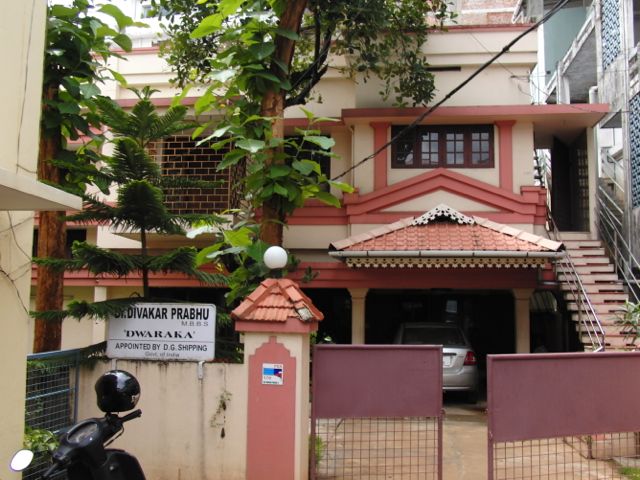 |
| A Trip to the Doctor's Office |
By the way, it appeared that this male doctor was a doctor that specialized in getting paperwork approved for Indians who wanted to work on ships. That’s why there were anchors on his door. We didn’t see any exam rooms but his outside waiting room was full of men that would meet with him and then leave holding a piece of paper. He probably was a real MD, but didn’t really practice like one.
He made a phone call and then told us that he made an appointment for us with a female doctor and that we needed to take his office boy with us and he would show the cab driver where to go. So, the cab driver drove the office boy and us to the Medical Trust Hospital in Cochin. (We learned later in Mumbai that a trust hospital is a public hospital and most Indians go to private hospitals.) The cab driver needed $1 for parking the car in the hospital’s dirt parking lot and then the office boy led us into the hospital and a small room that said “International Patients” and Snookums filled out some basic paperwork. Then the female office worker said “220” and we didn’t know if she meant dollars or rupees. She meant 220 rupees ($4.25) and this 220 rupee bill was split between 150 rupees ($2.90) for the doctor’s consultation and 70 rupees ($1.35) for the registration charge. We had no rupees so a “candy-striper” took us to the ATM on the second floor. While we were making the short hike, we passed tons of people as well as a large cart full of lunch trays. They were all hermetically sealed and looked like the type of hospital food that you would get in a US hospital. Snookums was impressed by what she saw.
After we got our rupees, we returned to the small office and paid our 220 rupee bill. Then we were taken to the doctor’s office. However, the doctor wasn’t ready to see Snookums yet so we waited in a large waiting room that was FULL of Indians. Filbert and Snookums stuck out like a sore thumb since all the other people were Indians. The waiting room was surrounded by the doctors’ exam rooms and every now and then some of the Indians would get up and go into one of the exam rooms. We never figured out how they knew when it was their turn, but they did. After 15 minutes or so, the candy-striper said it was Snookums’s turn and apologized profusely for the wait. We know that we were being put to the front of the line and didn’t mind the wait at all. Snookums and Filbert entered the exam room and found a female doctor behind a desk and two cheap plastic patio chairs on the other side. We sat down and the doctor said something and the office boy (from the first male doctor) and the candy-striper left. The nurse stayed in the room. Snookums explained her symptoms along with the two bug bites that she received in Bangkok. The doctor used an old-fashioned large metal flashlight (like Snookums used to take on her Girl Scout campouts before the era of plastic flashlights) to look in her eyes and her throat. Her blood pressure was taken, too, as was her temperature (via a thermometer placed in her armpit since that way it wouldn’t need to be sterilized!) while Snookums was sitting on the exam table with fabric sheets covering it (and not throwaway paper sheets). The doctor said that she wanted blood to be taken and would test for Dengue fever but she thought everything was fine and wasn’t going to prescribe anything. The doctor explained that it would take three days to get the lab results and when Snookums explained that the ship was leaving in a few hours and suggested that the results be emailed to her, the doctor agreed.
The candy-striper then took Snookums and Filbert to the blood work office and Snookums had to give a total of 659 more rupees ($12.76) for: Dengue fever antibody (600 rupees - $11.61), platelet count (50 rupees - $0.97) and single-use syringe (9 rupees - $0.18). After paying, Snookums went into the blood work room and a woman took her blood. The office worker at the desk hand labeled the two test tubes that would hold Snookums’s blood. After the worker took Snookums’s blood, she put the syringe with the blood in it in this rusty little box and then sparks came out. She removed the syringe from the box and Snookums saw that the single-use syringe was bent out of shape. Snookums thinks that the rusty little box was actually a grinder that ground off the syringe to prevent it from being used again. That’s what poverty is all about! The woman then poured the blood into the two hand labeled test tubes and put a Band-Aid on Snookums’s arm. Snookums, Filbert and the office boy returned to the international patients office and Snookums was given her official Medical Trust Hospital registration card (like a credit card) and was told that her lab results would be emailed to her. The office boy called the cab driver and we got in the cab to take the office boy back to the first doctor.
The office boy wanted Snookums to meet with the male doctor so she told him what happened and he wanted to make sure she understood that the lab results would be emailed to her. After five minutes or so of the male doctor talking about irrelevant things, Snookums said “thanks” and left. She expected to have to pay the male doctor something and figured that is why the office boy wanted her to see the male doctor again, but that was not the case. The office boy was with us for at least one hour plus Snookums “saw” the male doctor and there was no charge for any of this at all!
We got back in the cab and told the driver to take us back to the ship. The driver really wanted to take us on a tour but Snookums kept saying “No, I’m sick”. She wasn’t feeling bad, but she had no interest in seeing Cochin. We weren’t sure if our original $15 quote for the cab ride was one-way or round trip, but given that the driver was with us for around 3 hours, we decided to give him $30 when we got back to the ship just to be safe. What a day. We spent $30 for a cab and $18.01 for doctor visits and lab work. Only in India!
April 26 (Thursday, Day 21, Cruising the India Ocean) -
The pirate drill was today but we told our room stewardess we weren’t going to do it since Snookums still wasn’t feeling 100%. At 10:30 AM, the drill occurred and people had to go to corridors and stay low in order to not fall if the ship had to make sharp turns to get away from pirates.
April 27 (Friday, Day 22, Mumbai, India; 1 INR = $0.02; $1 = 51.66 INR) -
 |
| Mumbai |
We met our guide, along with another couple from another ship, and immediately drove to the Taj Mahal Palace Hotel which is located across from the Gateway of India. We had seen this before and weren’t too interested. But our guide wanted us to see the memorial to the people that died during the November 26, 2008 terrorist attacks so we went in the hotel. Then we drove to the Dharavi slums, an area half the size of New York’s Central Park, occupied by around 1 million people. This area contributes anywhere from $500 million to $1 billion to Mumbai’s economy.
We started our walking tour by seeing several recycling programs. A dark, single car garage-like structure had six or seven workers squatting in a row while passing trash down the human/manual assembly line. These workers were dwarfed by a huge mound/wall of garbage that reached the tall ceiling. The first person would take out specific types of recyclables and then scoot the garbage to the next person who would do something similar. It was kind of amazing to see this. We went to another recycling place and this one was only for women to work in since some of them don’t feel comfortable working so close to men due to their religious beliefs. (30% of Dharavi residents are Hindus and the rest are Muslim.) Then we went to a bakery where the rolls were stacked out front in wooden crates with flies and things crawling on them.
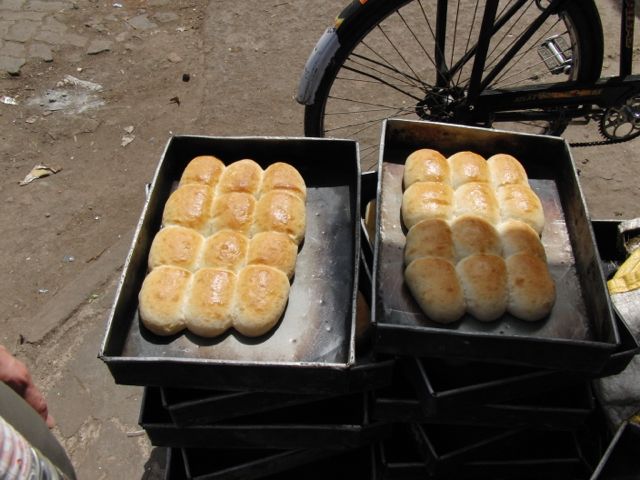 |
| Fresh bread! Hold the flies! |
Most of what is produced in the slums is sold throughout Mumbai (and the world) at leading establishments which is why photos aren’t always allowed. Indians don’t want people knowing where some of the Indian goods are coming from. After the bakery we saw a cardboard recycling shop that contained huge bundles of cardboard and some of it seemed to have been somehow made into “wood”. Most of these places didn’t have any machinery. The bakery had a wood-burning oven. We weren’t sure what happened to the sorted mounds of recyclables but six or seven workers were working in each small recycling shop. We also saw an oil can recycling shop and this had four girls squatting and using awful smelling chemicals to scrub the labels off the huge oil cans. The chemicals were definitely caustic and couldn’t be healthy and made our eyes run but the girls didn’t have any kind of protective gloves or masks. Our guide told us that after the oil cans were cleaned they would be refilled with cooking oil and sold. She said that the street vendors often use this kind of oil and that’s why people sometimes get sick from eating Indian street food. Reputable restaurants buy sealed news cans of cooking oil to use.
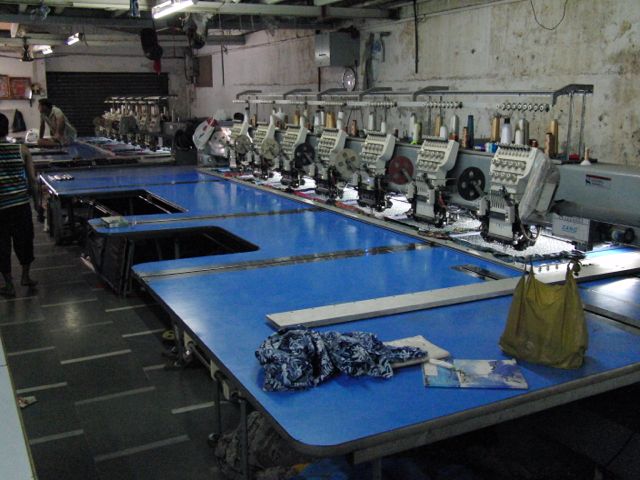 |
| Sweatshop |
We kept walking through narrow alleys and some of the buildings (definitely slums – there was no rhyme or reason as to how they were built) appeared to have the industry on the ground floor with living space on the second floor. There were also some buildings that just housed families in what looked like single rooms and a kitchen. Kids seemed to be everywhere and no one minded them. Scooters would drive through the alleys where the kids were playing cricket and where women would walk with pottery on their head. You definitely had to be awake to make sure you weren’t in the way. And, it was sunny, humid and 97° and not comfortable at all.
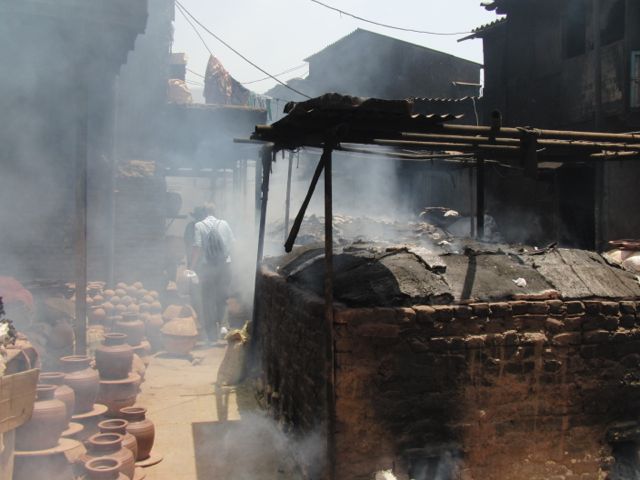 |
| Slum kilns |
We also saw several places that had ten people using sewing machines to make blue jeans and another place that had ten men making frilly dresses. We were taken into these one room places and had to step over fabric, food, and finished products. Stuff was just everywhere. Snookums saw a mouse running in one of the places and we all saw a slowly dying rat in an alley. Sanitation wasn’t a high priority and there didn’t appear to be any indoor plumbing since we saw one man brushing his teeth in the alley with a wash basin of water.
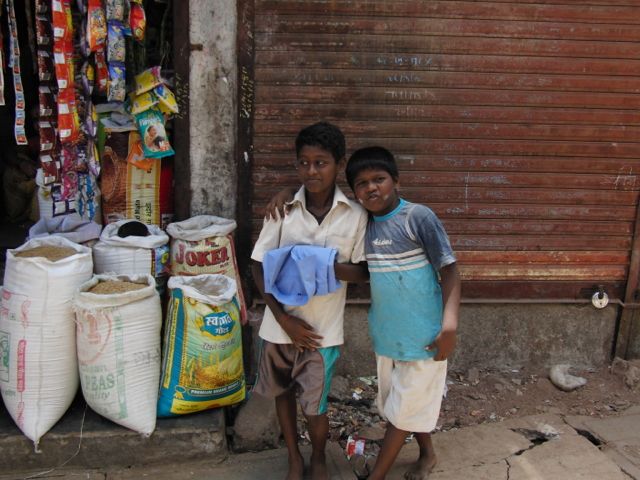 |
| Slum kids love to have their pictures taken. I don't know why. |
We then walked to the section of Dharavi that was the leather tannery section and saw a few men tanning leather. None of these operations were big. The frilly dress place had ten men working in it but it seemed like the other industries had less than five or so employees. We also saw the area where several pottery places were in business. It didn’t seem like any of these industries were selling any of the products to the locals. They appeared to be strictly wholesale. Even the bakery seemed to be making its rolls to sell to one buyer.
One of the last industries that we saw was the pappadam area. This was where women were given pappadam dough each morning and they would squat in front of their homes and roll it into flat, plate-sized shapes and then put them on drying racks and let them bake/dry in the sun. The women didn’t wear gloves and the drying racks weren’t protected. It should be noted that there were dogs running around, too. Our guide said that basically all of the pappadam bread that is eaten in Mumbai is made like this in the slums and this was one area where absolutely no photos were allowed. After seeing it, we weren’t going to eat any pappadam!
By now we were all very hot and sweaty and piled back in the air-conditioned car. The driver took us back to the port and the other couple left. Filbert and Snookums stayed in the car since Snookums really wanted to buy mojari shoes. She bought a pair in Hyderabad, India when they visited Snookums’s sister there several years ago and she wanted more. The guide took us to Colaba, which is the unofficial headquarters of Mumbai’s tourist scene with lots of touts, stores, stalls, hotels, a movie theatre and even a McDonald’s. We went into a couple of fancy shoe stores like you would find in the U.S. but the shoes didn’t feel right. As we walked down the street, the guide would stop at various shoe places and ask, in Hindi, about the shoes. She finally found a little stall that was literally built on either side of three exterior steps leading into a building. This is where Snookums found two pairs of mojaris for around $12 each. Even though we had the guide for another hour or two, we asked to return to the ship where we showered and put India behind us.
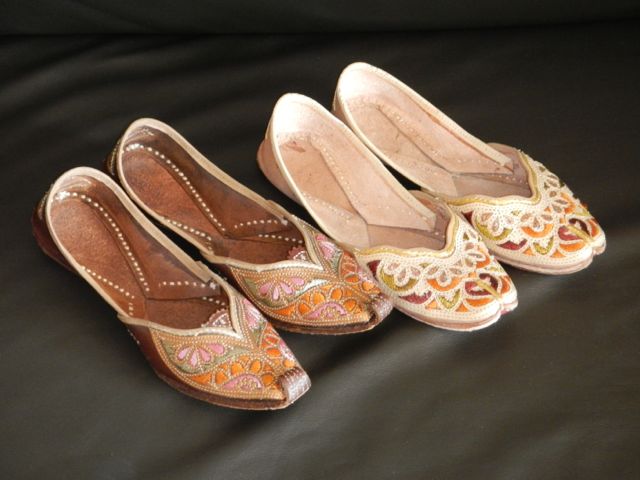 |
| Mojari shoes |
Snookums wanted to see dhobi ghat, the world’s largest outdoor laundry (all manual labor, of course), but she was tired and hot and called it a day. It had been a hot day and Filbert thought it was depressing. Snookums was amazed that people can live and work like that and have such a positive attitude. Our guide kept saying that they work hard in order to improve their lives and that is definitely what we saw. When we were in Rio de Janeiro, Brazil we visited its favelas (slums) but they were much nicer than Mumbai’s.